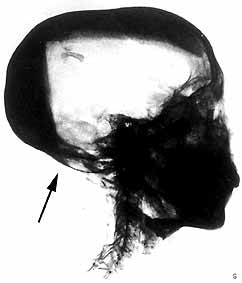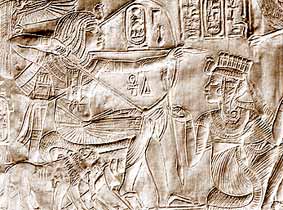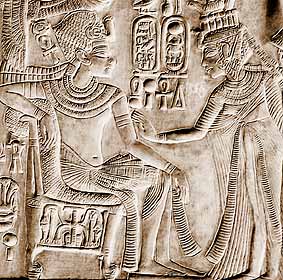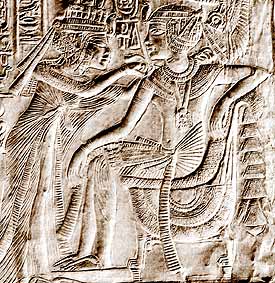|
Ever since the
discovery of the tomb of Tutankhamun there has been speculation
about the king's death - was he a victim of the backlash against
the Akhenaten / Amarna heresy? Had he been murdered to allow
his courtiers access to the throne? Or was he a sickly young
man whose genes had been affected by generations of in-breeding
by previous Egyptian pharaohs?
The different
views:
1. Murder - In a
recent book 'the Murder of Tutankhamun' by Bob Brier, a more
sinister motive for Tutankhamun's death is suggested. Brier also
uses his medical knowledge to look closer at the young King's
skull here he finds evidence that leads him to declare
that these bumps and marks are the reason for Tutankhamun's early
death (these same marks could most likely only be caused maliciously
he argues the area of the head which was damaged could
only have been reached by someone who had ready access to the
King, a servant for example. Interestingly both Ay and Horemheb
have left literary works denying themselves of any wrong doing
a text from Horemheb's statue warns 'Egyptian brothers,
don't ever forget what foreigners did to our king Tutankhamun'
which does indicate that Tutankhamun was indeed murdered!).
 the
arrow marks the location of the blow to the head
the
arrow marks the location of the blow to the head
2. Accidental - Marks and damage to Tutankhamun's
skull and subsequent death were caused accidentally the
usual romantic idea being a chariot accident.
However there are signs
that these bumps show sign of healing, other damage to the skull
could purely be caused during the embalming procedure.
3. Tutankhamun
was poisoned. This
latest theory comes from the Egyptian state information service
-
the information is very sketchy: 'Forensic examination carried
out . Reveal that he (Tutankhamun) was poisoned and it is now
suggested that the blow to the back of the head might have happened
after his death, during mummification. There is even a suspect
named Tutu (or Dudu) who first
appears as an official in the court of Amenhotep III, later in
the court of Akhenaten and finally in that of Tutankhamun, Tutu
is described as non-Egyptian, an unsavoury character who caused
friction.
(A link to the Egyptian state information service is available
on the LINKS page).
4. Death
by illness?
This is my own pure speculation several images of Tutankhamun
found in his tomb show a young man with his young queen, but
the same images also show him in several cases to be seated or
resting on a walking stick:
 |
 Further
images of a sitting Tutankhamun - including hunting while seated
(above)
Further
images of a sitting Tutankhamun - including hunting while seated
(above)
|
|
 |
 |
Of course the images
of Akhenaten (Tutankhamun's possible father or brother) found
at Amarna also show a king seated being served by his wife. Also
there are images of Tutankhamun from his tomb which do show an
active king (mowing down the enemies of Egypt in his chariot
for example) but there could be a case for a sickly young
Tutankhamun who was never destined to rule far beyond a few short
years who would not die from a blow to the back of the
head, from a chariot fall or from a foreign zealot but from illness.
Could the image of Smenkhkare
in fact be that of Tutankhamun? Another king leaning on
a walking stick? Or a mistaken identification?

|



